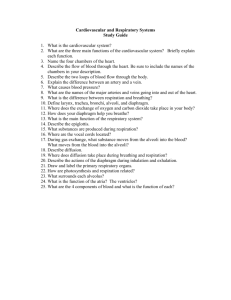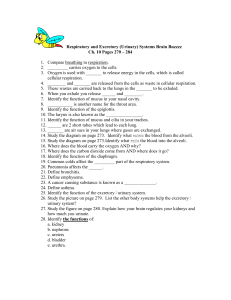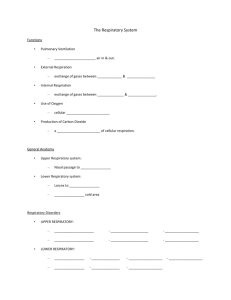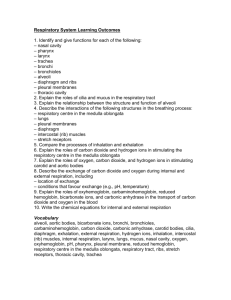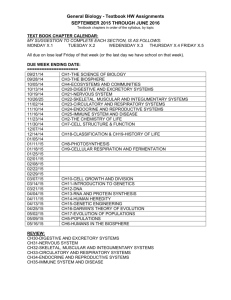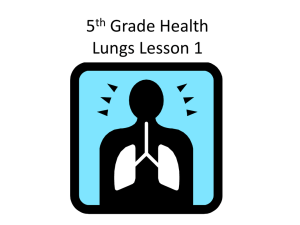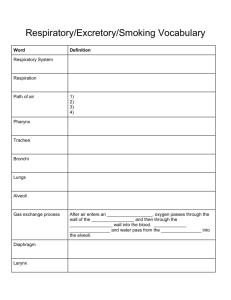Chapter 4 Review
advertisement
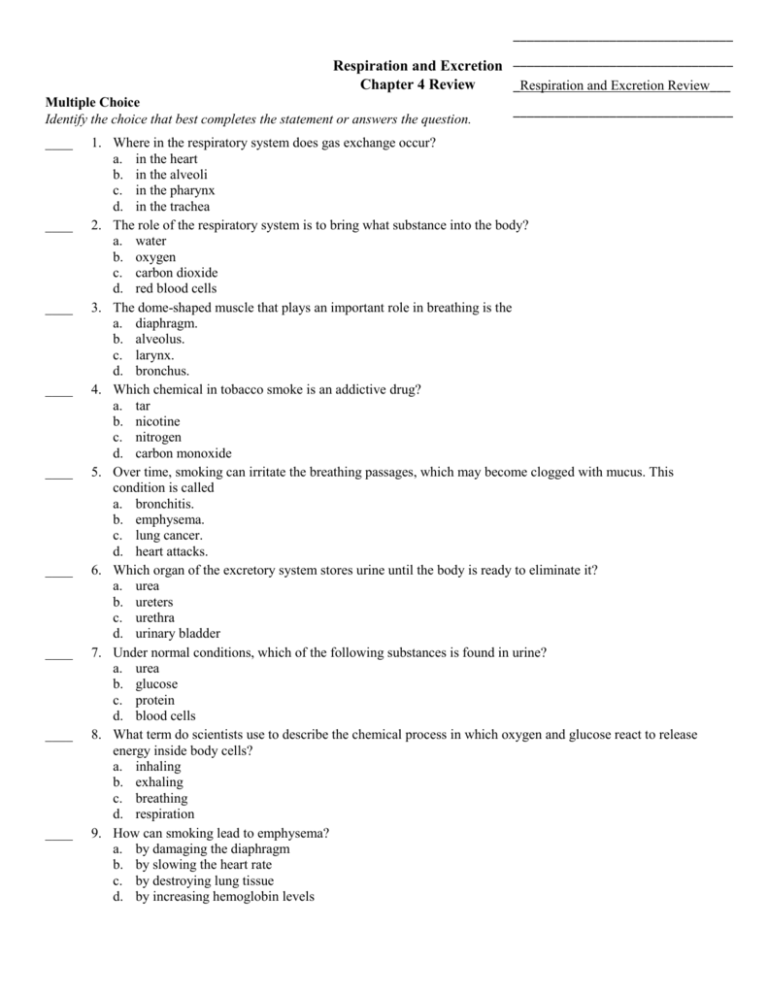
________________________________ Respiration and Excretion ________________________________ Chapter 4 Review _Respiration and Excretion Review___ Multiple Choice Identify the choice that best completes the statement or answers the question. ____ ____ ____ ____ ____ ____ ____ ____ ____ ________________________________ 1. Where in the respiratory system does gas exchange occur? a. in the heart b. in the alveoli c. in the pharynx d. in the trachea 2. The role of the respiratory system is to bring what substance into the body? a. water b. oxygen c. carbon dioxide d. red blood cells 3. The dome-shaped muscle that plays an important role in breathing is the a. diaphragm. b. alveolus. c. larynx. d. bronchus. 4. Which chemical in tobacco smoke is an addictive drug? a. tar b. nicotine c. nitrogen d. carbon monoxide 5. Over time, smoking can irritate the breathing passages, which may become clogged with mucus. This condition is called a. bronchitis. b. emphysema. c. lung cancer. d. heart attacks. 6. Which organ of the excretory system stores urine until the body is ready to eliminate it? a. urea b. ureters c. urethra d. urinary bladder 7. Under normal conditions, which of the following substances is found in urine? a. urea b. glucose c. protein d. blood cells 8. What term do scientists use to describe the chemical process in which oxygen and glucose react to release energy inside body cells? a. inhaling b. exhaling c. breathing d. respiration 9. How can smoking lead to emphysema? a. by damaging the diaphragm b. by slowing the heart rate c. by destroying lung tissue d. by increasing hemoglobin levels ____ 10. What is the name of the small flap of tissue that seals off the trachea during swallowing? a. pharynx b. larynx c. epiglottis d. alveoli ____ 11. Hairlike structures that line the nasal cavities and trachea are called a. cilia. b. mucus. c. bronchi. d. capillaries. ____ 12. Each alveolus is surrounded by a network of a. cilia. b. veins. c. arteries. d. capillaries. ____ 13. The vocal cords stretch across the opening of the a. diaphragm. b. larynx. c. bronchi. d. pharynx. ____ 14. What does nicotine do to the body? a. It slows the heartbeat. b. It reduces the desire to smoke. c. It increases blood pressure. d. makes cilia clump together. ____ 15. Organs of excretion that maintain homeostasis include the kidneys, lungs, skin, and a. diaphragm. b. bronchus. c. bladder. d. liver. Short Answer Use the diagram to answer each question. 16 - 25 Identify structures A through G. A. _______________________________________ B. _______________________________________ C. _______________________________________ G D. _______________________________________ H E. _______________________________________ F. _______________________________________ G. _______________________________________ H. _______________________________________ D I I. ________________________________________ J. ________________________________________ J Completion Complete each statement. 26. The movement of air into and out of the lungs is called ___________________________________. 27. After flowing through the nasal cavities, air enters the ___________________________________, or throat. 28. Dust in air that enters the nose is trapped by a sticky substance called ___________________________________. 29. Carbon dioxide and ___________________________________ pass from the blood into the alveoli. 30. Alveoli have a large __________________________________ that enables them to absorb a large amount of oxygen. 31. The ___________________________________, or voice box, is located in the top part of the trachea. 32. The dome-shaped muscle that helps move air in and out of the body is the __________________________________. 33. Tobacco smoke contains the gas ___________________________________, which replaces some of the oxygen that red blood cells normally carry. 34. Tobacco smoke contains a substance called _________________________________ that makes cilia clump together. 35. The ___________________________________ system collects blood and removes wastes that are produced by cells. 36. Aside from excess water, the excretory system eliminates the chemical ___________________________________, which comes from the breakdown of proteins. 37. Urea, excess water, and other waste materials are eliminated in a watery fluid called __________________________. 38. The ureters carry the urine to the ___________________________________, a muscular organ that stores urine. 39. The kidneys contain tiny filtering units called ___________________________________. 40. The process in which energy is released from glucose is called cellular __________________________________. Selection: Circle the correct word to make the statement true. 41. The respiratory system removes ( oxygen / carbon dioxide ) and water from the body. 42. Oxygen and carbon dioxide are exchanged in capillaries that surround tiny sacs called ( bronchi / alveoli ). 43. During the reabsorbing process in the nephron, glucose is normally ( left in the tube / reabsorbed ). Essay All answers must be written using 6-traits, fully developed, and supported with details. 44. Describe what happens during inhalation and exhalation. Be sure to refer to what is happening to the diaphragm, chest muscles, and rib cage. Also, what is happening to the volume of air and the air pressure. _____________________________________________________________________________________________________________ _____________________________________________________________________________________________________________ _____________________________________________________________________________________________________________ _____________________________________________________________________________________________________________ _____________________________________________________________________________________________________________ _____________________________________________________________________________________________________________ _____________________________________________________________________________________________________________ _____________________________________________________________________________________________________________ _____________________________________________________________________________________________________________ ____________________________________________________________________________________________________ ___________________________________________________________________________________________________ 45. Explain the difference between breathing and respiration. _____________________________________________________________________________________________________________ _____________________________________________________________________________________________________________ _____________________________________________________________________________________________________________ _____________________________________________________________________________________________________________ _____________________________________________________________________________________________________________ _____________________________________________________________________________________________________________ _____________________________________________________________________________________________________________ _____________________________________________________________________________________________________________ _____________________________________________________________________________________________________________ ___________________________________________________________________________________________________________ __ ___________________________________________________________________________________________________ 46. Explain the negative impact cigarette smoke has on the body, give examples. What disease can smokers get? Also, explain why smokers have difficulty quitting smoking. _____________________________________________________________________________________________________________ _____________________________________________________________________________________________________________ _____________________________________________________________________________________________________________ _____________________________________________________________________________________________________________ _____________________________________________________________________________________________________________ _____________________________________________________________________________________________________________ _____________________________________________________________________________________________________________ _____________________________________________________________________________________________________________ _____________________________________________________________________________________________________________ ____________________________________________________________________________________________________ ___________________________________________________________________________________________________ 47. Compare and contrast the functions of the excretory system and the respiratory system. _____________________________________________________________________________________________________________ _____________________________________________________________________________________________________________ _____________________________________________________________________________________________________________ _____________________________________________________________________________________________________________ _____________________________________________________________________________________________________________ _____________________________________________________________________________________________________________ _____________________________________________________________________________________________________________ _____________________________________________________________________________________________________________ _____________________________________________________________________________________________________________ ____________________________________________________________________________________________________ ___________________________________________________________________________________________________ ESSAY A. During inhalation, the diaphragm and chest muscles contract. When this happens the rib cage raises causing an increase in air volume and a decrease in air pressure. During exhalation, the diaphragm and chest muscles relax. When this happens the rib cage lowers causing a decrease in air volume and an increase in air pressure. B. Breathing is the movement of air into and out of the lungs. Respiration, which is also called cellular respiration, is the process in which oxygen and glucose chemically inside of the cells. The cells then release the energy that fuels growth and other cell processes. C. Tar in cigarette smoke causes the cilia to clump together so they are not able to prevent harmful materials from getting into the lungs. The cilia cannot sweep away mucus causing many smokers to have a frequent cough. With the buildup of mucus the space for airflow decrease causing a decrease in oxygen. Long term smokers are often short of breath, may have atherosclerosis, hypertension, emphasema, and or lung cancer. Tobacco contains an addictive chemical called nicotine. Smokers crave a cigarette if they go without one. The addiction is so strong that smokers have a hard time quitting. D. Both the respiratory and the excretory systems collect wastes from cells and remove them; the respiratory system, however, also supplies the body with a needed material—oxygen. The respiratory system eliminates carbon dioxide and some excess water in the alveoli of the lungs. The excretory system removes urea, excess water, and some other materials in the kidneys.
